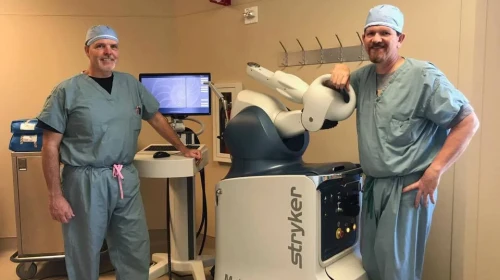Hip Replacement Surgery
Today’s patients are more active than ever and want to maintain a healthy, mobile lifestyle. Total hip replacement is an excellent option for individuals experiencing hip pain, stiffness, or arthritis who wish to return to comfortable daily movement.
Hip Replacement
Hip replacement surgery, also called hip arthroplasty, is a procedure designed to relieve pain and restore mobility for people with significant hip discomfort or loss of function. The goal of hip replacement is to remove damaged portions of the hip joint and replace them with durable artificial components that move smoothly and comfortably.
Most hip replacements are performed to treat advanced hip arthritis. When hip cartilage wears down, the bones rub together, leading to:
- Severe hip pain
- Loss of mobility
- Stiffness
- Difficulty walking
- Painful daily activities such as standing, sitting, or getting in and out of a chair
Hip replacement may also be used to treat:
- Broken or damaged hip bones
- Structural hip deformities
- Severe hip impingement
- Degenerative joint conditions
Patients who undergo hip replacement commonly report:
- Persistent pain that interferes with daily tasks
- Pain that does not improve with medications or walking aids
- Stiffness that limits movement and activity
Hip Joint Anatomy
The hip is a ball-and-socket joint. The round femoral head sits inside the acetabulum, a curved socket in the pelvis. Healthy cartilage lines both surfaces, acting as a cushion and allowing smooth, friction-free movement.
When cartilage is worn away due to arthritis or injury, the bones rub together. This creates pain, inflammation, stiffness, and difficulty moving the leg.
Our Philosophy
At Andrews Sports Medicine, our philosophy is to partner closely with each patient to help them reclaim their mobility and quality of life.
The first step in evaluating a hip for possible replacement is an office visit. During this visit, our team will:
- Review your medical history
- Conduct a physical examination
- Order and review X-rays
Even if arthritis is advanced, non-operative treatment is usually tried first. This may include:
- Weight loss (if appropriate)
- Activity modification
- Anti-inflammatory medications
- Injections
- Physical therapy
If pain continues to interfere with daily life despite these treatments, then hip replacement becomes a strong option.
The choice to proceed with surgery is made together—between the patient, the surgeon, and their loved ones. The best time for hip replacement is when pain forces you to plan your life around what your hip will or won’t allow you to do.
Types of Hip Replacement Surgeries
The most common procedure is total hip replacement, in which damaged parts of the joint are removed and replaced with artificial components.
During a total hip replacement:
- The worn-out socket is replaced with a titanium metal shell
- A plastic or ceramic liner is inserted to allow smooth hip motion
- The femoral head (ball) is removed
- A new metal ball is attached to a metal stem placed inside the femur
Surgeons may access the hip from the:
- Back of the hip
- Side of the hip
- Front of the thigh
The approach chosen depends on patient anatomy, surgeon expertise, and specific treatment goals.
Anterior Total Hip Arthroplasty
Anterior total hip replacement accesses the hip joint from the front of the thigh. This technique allows the surgeon to work between muscles without cutting major muscle groups. Advantages may include:
- Less pain immediately after surgery
- Faster early recovery
- Smaller soft-tissue disruption
However, the anterior approach requires specialized equipment and training and may not be appropriate for all patients.
Direct Superior Total Hip Arthroplasty
The Direct Superior approach is a modern variation of minimally invasive hip replacement surgery. This technique is designed to be even more muscle-sparing than the direct anterior approach, which became popular in recent years. By preserving more soft tissue around the hip, this approach may allow for:
- Reduced postoperative pain
- Faster early mobility
- Shorter initial recovery time
In addition to advancements in technique, improved physical therapy protocols and enhanced pain-management strategies help patients return to walking and daily activities more quickly and comfortably.
Posterior Total Hip Arthroplasty
The posterior approach accesses the hip joint from the back of the hip and remains the most commonly used method in the United States. This approach offers excellent visibility of the hip joint, allows surgeons to accurately place implants, and is appropriate for a wide range of patients. It continues to be a reliable and effective option for total hip replacement.
How Long Does a Hip Replacement Last?
Modern hip replacements are designed to be durable and long-lasting. On average, a total hip replacement lasts 15 to 20 years, but many implants last even longer. A more accurate way to understand longevity is by looking at the annual failure rate of hip implants.
Most current research shows that hip replacements have an annual failure rate of 0.5 to 1.0 percent. This means:
- Patients have a 90 to 95 percent chance their hip replacement will still function well at 10 years.
- Patients have an 80 to 85 percent chance their hip replacement will still function well at 20 years.
As implant materials and surgical techniques continue to improve, these numbers are expected to rise.
Even with excellent long-term success rates, patients should maintain regular follow-up visits with their surgeon to ensure the hip replacement is functioning properly and to identify any potential issues early.
To request an appointment online, CLICK HERE or contact Andrews Sports Medicine & Orthopaedic Center at (205) 939-3699.
Back to Hip








